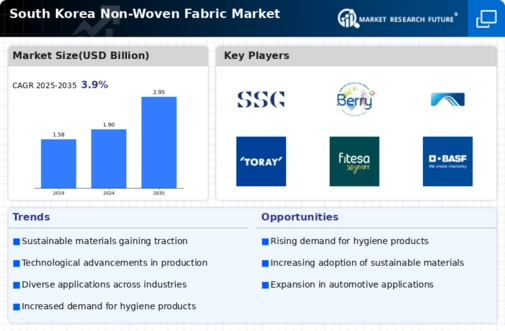The South Korea Non-Woven Fabric Market is characterized by a dynamic and fiercely competitive landscape that has experienced significant growth in recent years. This growth can be attributed to rising consumer awareness regarding hygiene and health, alongside an increased demand for sustainable materials. Companies in this market have been adapting their strategies to leverage technological advancements, provide innovative products, and explore sustainable practices to maintain an edge over competitors. The influx of both domestic and international players has intensified competition, leading to a plethora of options for consumers in sectors such as healthcare, hygiene, automotive, and construction.
Additionally, the focus on sustainable manufacturing processes and eco-friendly materials is reshaping the market, as various stakeholders seek to minimize environmental impact while catering to evolving consumer preferences. Sustainability Solutions has established a notable presence in the South Korean Non-Woven Fabric Market by emphasizing eco-friendly practices and sustainable products. The company's commitment to sustainability resonates strongly with both consumers and businesses in South Korea, which is increasingly prioritizing environmental responsibility.
By ensuring that their non-woven fabrics are made from recycled materials and applying innovative production processes that minimize waste, Sustainability Solutions has positioned itself as a leader in sustainable fabric solutions. The company's strengths lie in its advanced technology and research capabilities, which enable the creation of high-performance non-woven fabrics that meet stringent quality standards while promoting eco-friendliness.
This strategic focus on sustainability not only enhances brand reputation but also fosters strong relationships with clients who are keen on sustainability.Berry Global has made significant inroads into the South Korean Non-Woven Fabric Market, where it is recognized for its diverse range of high-quality products and strong market presence. The company specializes in manufacturing non-woven fabrics that cater to a broad array of applications, including hygiene products, medical supplies, and industrial uses. Berry Global's strengths include its commitment to innovation and product development, which has led to the introduction of various key products tailored specifically for the South Korean market.
The company has also strengthened its foothold through strategic mergers and acquisitions that enhance its production capabilities and logistical reach. By focusing on delivering superior quality products and leveraging economies of scale, Berry Global has been able to meet increasing demands effectively, maintaining a competitive advantage in the rapidly evolving landscape of South Korea's non-woven fabric industry.






















Leave a Comment